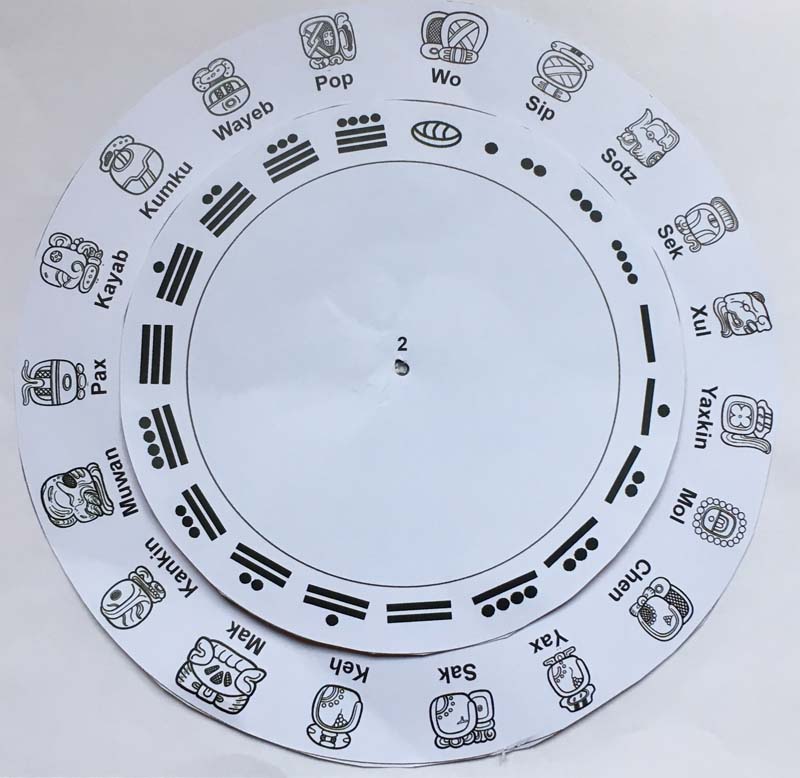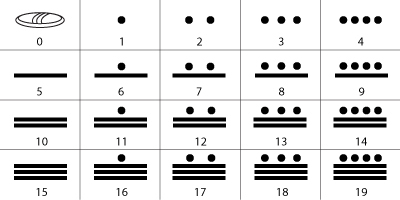The Maya Calendar Explained
The Maya calendar (and time keeping in pre-Columbian Mesoamerica) is a fascinating, but poorly understood topic that has gathered much interest in recent years (particularly around 2012). In this article, I will explain how the Maya calendar works and how to read it.

Time was extremely important to the Maya, they made elaborate and accurate calendars and used them in charting the movements of the sun, moon, stars and even planets.
These calendars served a variety of purposes both practical and sacred. They were used in astronomical calculations, divination and recording important events, such as the reigns of rulers and their conquests.
Page Content:
- Introduction: The Maya calendars
- The 260-day count (Tzolk’in)
- The 365-day count (Haab)
- The 52-year count (Maya calendar round)
- The Long Count
- Date Conversion Calculator
- Maya Calendar facts
- Further resources
How does the Maya calendar work?
In the late 19th century, Ernst Forstemann worked out how the Maya marked time. The Maya used what is now known as the calendar round which is made up of 3 interlocking cycles. A cycle of 20 names, a cycle of 13 numbers (which forms the 260-day sacred calendar) and a 365 days solar year. 52 years will pass until the three cycles line up again.
The following video -taken from the acclaimed documentary Breaking the Maya Code- gives a great overview:
The Sacred Calendar (Tzolk’in) 260 days
The 260-day calendar, also known as the Sacred Calendar or Tzolk’in, has 20 days associated with the numbers 1-13 (20 x 13 = 260). It would run as follows: 1 Imix, 2 Ik, 3 Akbal, 4 Kan… to 13 Ben, then number one would return and become associated with the fourteenth day: 1 Ix, then 2 Men, 3 Kib and so on continuing in an endless cycle.
Every day was significant, similar to an astrology chart.

Notice that the Maya did not have numbers like ours, they only had three digits; a dot standing for ‘one’, a bar standing for ‘five’ and a shell for ‘zero’ (see my article on Maya mathematics)
For example: 4 would be 4 dots, 5 would be 1 bar, 10 would be 2 bars and 13 would be 2 bars and 3 dots.
The Solar Calendar (Haab) 365 days
The solar calendar contained 19 ‘months’ – 18 months of 20 days and a closing month of 5 days (Wayeb).

For example: 0 Pop would be followed by 1 Pop, then 2 Pop, up to 19, then it would be 0 Wo, 1 Wo and so on.
When these two calendars (Tzolk’in and Haab) are working together, one day in this round such as “3 Kan 8 Pop” did not repeat until 52 years passed, which was called the Calendar Round.
So you basically have a number + day + number + month.

The Long Count
Like our own calendar the Maya marked dates for more extensive time from a fixed starting point. In our calendar it is the birth date of Christ, for the Classic Maya the beginning of the present creation was 13th August, 3114 BC.
Each great cycle lasted 5128 years and it repeated indefinitely. The first great cycle was to end on 21 December 2012. This led to the popular idea that the Maya prophesied the world was to end on that date. However, this is completely a modern invention, time was not lineal for the Maya, but cyclical and ever repeating.
Now that you have a general idea of the Maya calendars, let us look at them in more detail.
The Tzolk’in: the 260-day count
The 260-day count, which approximates the human gestation period, as well as the time it takes for a maize plant to come to fruition, is still used in some Maya communities today, mostly in the highlands of Guatemala.
It was, and still is, a sacred almanac that provided a chronological framework for Maya ceremonial life, and a basis for prophecies.
Birthdates were recorded by this calendar, and the patron deity of a particular day became closely associated with the destiny of babies born on that day.
The Tzolk’in is a succession of 260 days made up of the permutation of 13 numbers with 20 names (13 x 20 = 260), very much in the same way our months consist of the association of 7 week days (Monday to Sunday) and 28, 29, 30 or 31 numerals (for example Friday the 13th which is the 13th day of the month and the 5th day of the week).
Each day is uniquely designated by the combination “coefficient/day-name”, and not until every single one of the numbers 1 through 13 had been attached to every one of the 20-day names was the cycle complete. It would take 260 solar days to complete.

The first day of the Tzolk’in is “1 Imix”, the second is “2 Ik’”, the third is “3 Ak’bal”, the thirteenth is “13 Ben”, the fourteenth is “1 Ix”, the twenty-first is “8 Imix”, and so on.
A particular combination will not recur until 260 days have elapsed.

Day Keeping
This sacred calendar is still used by the highland Maya people today. Each community has their day keeper, generally a shaman, who carries out ceremonies on particular days of this calendar. People will visit the day keepers to ask questions about their future or help in curing an illness. Day keepers then ask the spirits for guidance.
Both the ancient and highland modern Maya believe that they have a spirit/animal companion, the ancient Maya called it Way (pronounced ‘Why’) and the Maya today call it their nahual/nawale. Your birthdate defines what animal/spirit companion you have and also tells you your character traits.
Below is the list of the 20 nahales and their respective calendar name, both in the Yucatecan Mayan language (in italics) and the highland Mayan language of Kaqchikel (in bold).
- Crocodile – Imix – Imox
- Wind – Ik – Iq
- Night – Akbal – Aqabal
- Sky – Kan – Kat
- Snake – Chikchan – Kaan
- Death – Kimi – Kame
- Deer – Manik – Kiej
- Venus – Lamat – Qaniel
- Moon – Muluk – Toj
- Dog – Ok – Tzi
- Howler monkey, ancestor – Chuwen – Baatz
- Tooth/Jaw – Eb – E
- Maize – Ben – Aaj
- Jaguar – Ix – Ix-balaam
- Eagle – Tzikin – Men
- Candle – Kib – Ajmaq
- Earth – Kaban – N’oj
- Flint, obsidian – Tijax
- Storm – Kawak – Kawoq
- Lord – Ajaw – Ajpu
The Haab: the 365-day count
Sometimes called the “Vague year” because leap year adjustment was never intercalated, the Haab is a 365-day period.
It is made up of 18 months of 20 days, and an extra month, called Wayeb, of only 5 days at the end of the year, which gives a total of 365 days. Those 5 extra days were usually considered be special days.
The months’ names are all taken from the Maya Yukatec list given to us by Bishop Diego de Landa in the 16th century: Pop, Wo, Sip, Sots’, Sek, Xul, Yaxk’in, Mol, Ch’en, Yax, Sak, Keh, Mak, K’ank’in, Muwan, Pax, K’ayab, Kumk’u and Wayeb.
The 365-day count operates very much like our own calendar: the first month is “Pop”, and the first day of the year is “1 Pop” followed by “2 Pop”, and “3 Pop”, and so on until “19 Pop”. The following day is referred to as the “seating”, or “putting in place”, of the next month (Wo) and transcribed as “0 Wo” (the Maya had figured out the concept of “zero”).
The unusual aspect of this calendar is that the “seating” of a given month is not considered as the first day of the month but rather as the last day of the previous one. This is akin to the tradition of calling December 31st “New Years Eve”.

The Maya Calendar round
A Calendar Round date gives the position of a given day in both the 260-day count (Tzolk’in) and the 365-day count (Haab).
It is always written in the same order: (1) day coefficient + day name in the Tzolk’in, and (2) day number + month name in the Haab.
Since 260 and 365 have a least common denominator of 5, it will take 18,980 days (260 x 365/5), approximately 52 years, before a specific date in the Calendar Round recurs.
The 52-year count was in use throughout Mesoamerica
The Mexica (Aztecs), for example, called these periods xiuhmolpilli, meaning “year bundle”. The start of a new xiuhmolpilli was cause for much celebration. The Mayan name for these 52-year periods is not known.
The association of the 20-day cycle in the Tzolk’in and the 20-day months in the Haab creates a noteworthy phenomenon: for any given year, the first day of all the months in the Haab will start with the same Tzolk’in day. For example, if the first day of the year (1 Pop) falls on a day Ben in the Tzolk’in, then the first day of every month in that year will be on a day Ben. These days are called “Year Bearers”.
Given the short month of 5 days (Wayeb) at the end of the Haab, the first day of the following year has to be 5 days later in the Tzolk’in.
Since there are only 20 days in the latter, there can be only 4 Year Bearers.
During the Classic times, these were Ak’bal, Lamat, Ben, and Etz’nab. The same traditional year-bearer pattern continues in some traditional highland Maya communities. By the time of European contact, however, the year-bearers used in the Yucatec calendar were K’an, Muluk, Ix, and Kawak.
The Maya Long Count
Moving on from this was their absolute dating system, which we call the Long Count. Like our own calendar the Maya marked dates for more extensive time from a fixed starting point. In our calendar it is the birth date of Christ, for the Classic Maya the beginning of the present creation was 13th August, 3114 BC. Each great cycle lasted 5128 years and it repeated indefinitely.
Every inscription began with the date, usually the long count date and then followed by the calendar round (Tzolk’in date + Haab date).
The base unit in the Long Count was the day (K’in). Since the Maya used a vigesimal numeral system (i.e. based on 20, the same way our decimal system is based on 10), they used a period of 20 days (Winal) which in turn was grouped in packs of 18 (not 20, probably to approximate the solar year) called Tun, and then Katun which is 20 Tuns, and Baktun which is 20 Katuns and so on.

The Long Count then is the counting of days since the last creation and was divided into:
K’in = 1 day
Winal = 20 days (20 K’ins)
Tun = 360 days/K’ins (18 Winals)
K’atun = 7,200 days (20 Tuns)
Bak’tun = 144,000 days (20 Ka’tuns)

Date Conversion Calculator
You will find the full Maya long count date for today below. However, if you want to find out what any date in our time would be in the Maya calendar, simply type in your chosen date and click the convert button.
Long Count Date
13.0.8.11.8
13 B’aktun
13 X 144,000 days = 1,872,000 days
0 K’atun
0 X 7,200 days = 0 days
8 Tun
8 X 360 days = 2,880 days
11 Winal
11 X 20 days = 220 days
8 K’in
8 X 1 day = 8 days
Tzolkin Date: 5 Lamat
Haab Date: 6 Sek
Lord of the Night: G3
Lord of the Night: There were nine gods who ruled over the Maya night, called the “Lords of the Night”. Each would rule for one night and then change to the next, continuing in an endless cycle.
*Correlation Constant used is 584283 – Goodman-Martinez-Thompson.
Maya Calendar Facts
How accurate is the Maya calendar?
The Maya did not use any system of leap days, so the Haab had an error rate of 1 day every 4 years when compared to the real solar year.
How many days did the Maya calendar have?
The Haab has 365 days (18 months of 20 days + 5). The Tzolk’in has 260 days (20 names and 13 numbers). The calendar round has 18,980 days (52 years).
Did the ancient Maya predict that the world would end on 21 December 2012?
No, they did not! A great cycle of the Maya Long Count was to end on 21 December 2012, but the next day the Maya believed that a new cycle would begin. There was to be no end of the world.
In fact, in the temple of inscriptions at Palenque, where we find the tomb of King Pakal, was written that in AD 4772 the people would be celebrating the anniversary of the coronation of their King Pakal.
Further Resources on the End of the World
Anthony Aveni (2009) The End of Time: The Maya Mystery of 2012, University Press of Colorado, Boulder
David Stuart (2011) The Order of Days: the Maya World and the Truth about 2012. Harmony. New York
Online Resources
FAMSI website has an excellent discussion and powerpoint of this phenomenon – http://www.famsi.org/research/vanstone/2012/index.html
Online Videos
The End of Time The Maya Mystery of 2012
University of Pennsylvania Museum of Archaeology and Anthropology (2012)
Conference by Prof. Anthony Aveni
Duration: 70 min
Dr Anthony F. Aveni, author of the bestselling book, The End of Time: The Maya Mystery of 2012, explores theories about the widely prophesized “end of the world” in December 2012, by measuring them objectively against the evidence of archaeology, iconography, and epigraphy.
The Maya and 2012: Fact, Fantasy, and Phenomenon
University of Pennsylvania Museum of Archaeology and Anthropology (2012)
Conference by Dr Simon Martin
Duration: 59 min
Prior to 2012, there had been a gathering storm of publicity surrounding an “end of time” arriving in December 2012, based on the Maya calendar.
What did the ancient Maya really believe would take place?
Dr Simon Martin, Research Specialist, Penn Museum, helps to form a more accurate picture of ancient Maya beliefs.
Products
Own a handmade wooden Maya calendar:




[…] Learn more about the Maya calendar […]
Very interesting and informative
Thank you, I am glad it is of use.
[…] [1] Davies, Dianna. “The Maya Calendar Explained (KS2).” Maya Archaeologist. January 15, 2018. Accessed April 04, 2018. http://mayaarchaeologist.co.uk/index.php/2016/12/31/maya-calendar-system/. […]
Hi, i wanna congratulate you for this post. It’s so complete and precise. Sorry if i don’t write very good it’s because i am from Argentina. Thanks! Really help me in my presentation!
Thank you, i am glad you found it of use. Your English is perfect, actually i lived in Argentina for awhile and my dog is from Buenos Aires!
i due not understand
its a really good website’
im only ten but i really enjoyed learn about the mayan calendar in class but this website made it even easier for me to learn about it
Why, thank you – that is lovely to hear!
The way that it is explained makes it very informative for my Guided Inquiry Project.
This is very helpful, I love studying about the Mayans, this has helped me a lot, especially how I’m also studying how to write in the glyphs. Might be easier to use the calendar with this.
really intresting
Hi. This is really informative and as I am trying to explain to various people that the mayans did not actually predict the end of the world this presentation is great it shows everything, I can now forward your site and happily not look at confused faces while trying to explain end of cycles and beginning of new ones.
Wonderful! I’m glad it is of use to you.
This is website is great! I am fascinating about Maya civilization. I have been to Copan many times. I wish there would be more resources like this available to learn Mayan language and culture.
Thank you! A new and improved website with many more resources will be live in September!
Hi Diane,
I wanted to say thank you for such a fantastic resource to help us year 6 teachers with teaching the Maya accurately. Our pupils are loving finding out all about this amazing civilisation and I’m pleased to hear there will be even more resources from September. Many thanks, Emma.
it is a great site for schoole work
Yes i agree with anonymous it is great for school work.
I agree with anonymous and shepherd. Great website good info
This is my first dive into understanding how the Mayan calendar works. Thank you for your insight.Very easy to follow.
This is much better than the irritating explanation in Coe.